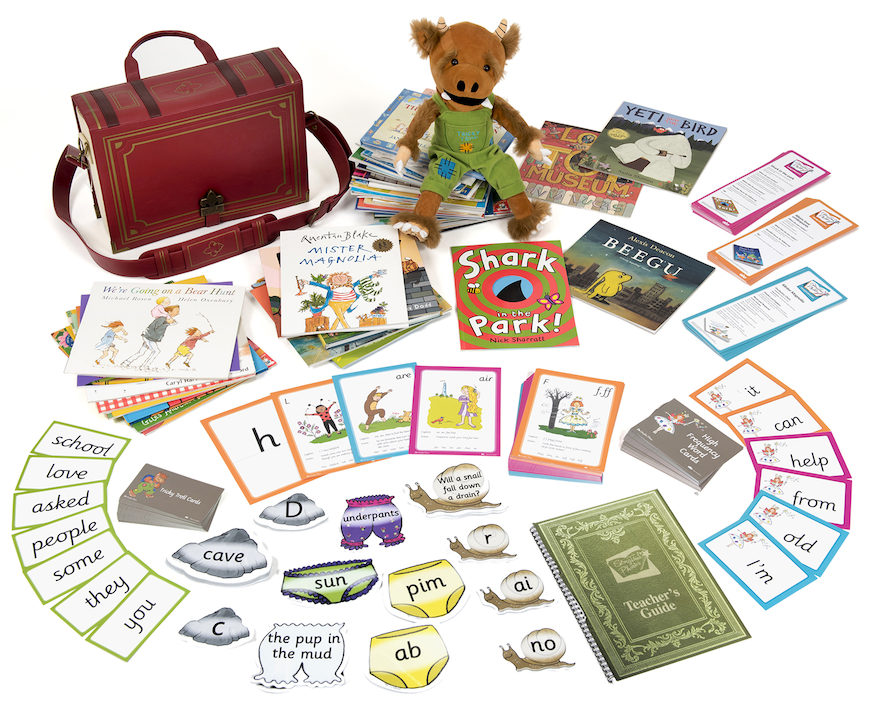
A significant part of learning to read is having something you want to find out and a significant part of learning to write is having something you want to say. Children do not cap their thoughts and curiosity based on the phase of phonics they happen to know. Children are magical, crazy learning machines. They put snails in their mouths just to find out what slime tastes like; they mix milk and washing-up liquid and mud together to make magic potions; they wade through muddy puddles to watch the ripples turn into tidal-waves. They exasperate their parents with questions like ‘What would happen if mammoths got their tusks stuck in a fire-engine’s hose?’ drawn from a seemingly bottomless well of curiosity. Children want to talk and read and write about the endless variety of the world around them and to make sense of it in their own way. They do not want to think only about the parts of the Universe we can name with CVC words.

Taught well, synthetic phonics teaching can give children some tools to help them express themselves and find out what they want to know. Taught out of context, with little purpose other than getting better at phonics and without a deep understanding of the relationship between spoken and written English, phonics can be a de-motivating experience for children and set up a long-term tension between what they want from school and what they actually get from it.

So, how to keep the motivation and the magic, alongside systematic teaching of phonics?
Make the experience as rich as possible:
A multi-sensory approach means so much more than simply using magnetic letters or phonics frames. The world is full of sights and smells, textures and tastes, and every great story or poem weaves these into every page. Even more than that, our language is fraught with emotion – fear, hope, dreams, suspense. The more children experience the language and a text through drama, through play, through touch and feel and movement of their whole body, the more they will have a hook to hang their new understanding on. The more they sense the language as a part of their magical, wonderful world, the more they will see that their new phonics knowledge can help them explore that world.

Explore the deep connections between spoken and written English:
The sounds and the sights of English are connected, but the roots are deep and complex. Phonics at phase 4 and beyond starts to hint at the complexity, and this can be a significant hurdle for many pupils. Many parents will not have an understanding of how phonics relates to written English as they were taught it, and so will find it difficult to support at home. Also, many teachers lack confidence in just how deep to go in order to help pupils unpick the patterns and the exceptions to the rules that start to appear after phase 3 has finished. To teach these patterns in context requires much more than a sound understanding of the phonics phases, it requires a sense enjoyment to be had.
Use brilliant stories:
No one can resist a well-told story and the pull of what’s going to happen next, or to find out if the hero will save the day; even though we know everything will probably turn out for the best, we still want to find out. It’s in our DNA. On the other hand, anyone can resist learning taken out of its rich context and put forward just for its own sake. The English language is incredibly rich, with a deep history and a very wide vocabulary. Its rhythms and patterns have been passed down to us in songs and rhymes and tales of wonder, in fairy tales and snippets of Shakespeare and in the language children use to convince, cajole and discover.

For ideas and inspiration to help teach phonics take a look at our phonics resources.
Read part 1, part 2, part 3 and part 4 (Who is the Phonic Fairy?) from this series of ‘For the Love of Phonics’ blogs.
With thanks to Michelle Larbey for writing this blog.
Michelle Larbey is a former Leading English teacher and Local Authority Consultant who now spends her time as a freelance English consultant and author. Known for her passion and enthusiasm, Michelle’s innovative research based approaches inspire and motivate both children and teachers alike. Michelle also works part-time for the Faculty of Education, Cambridge University supporting PGCE students in the highest standards of research and teacher training. In her spare time, she likes nothing more than to read to her two children.



